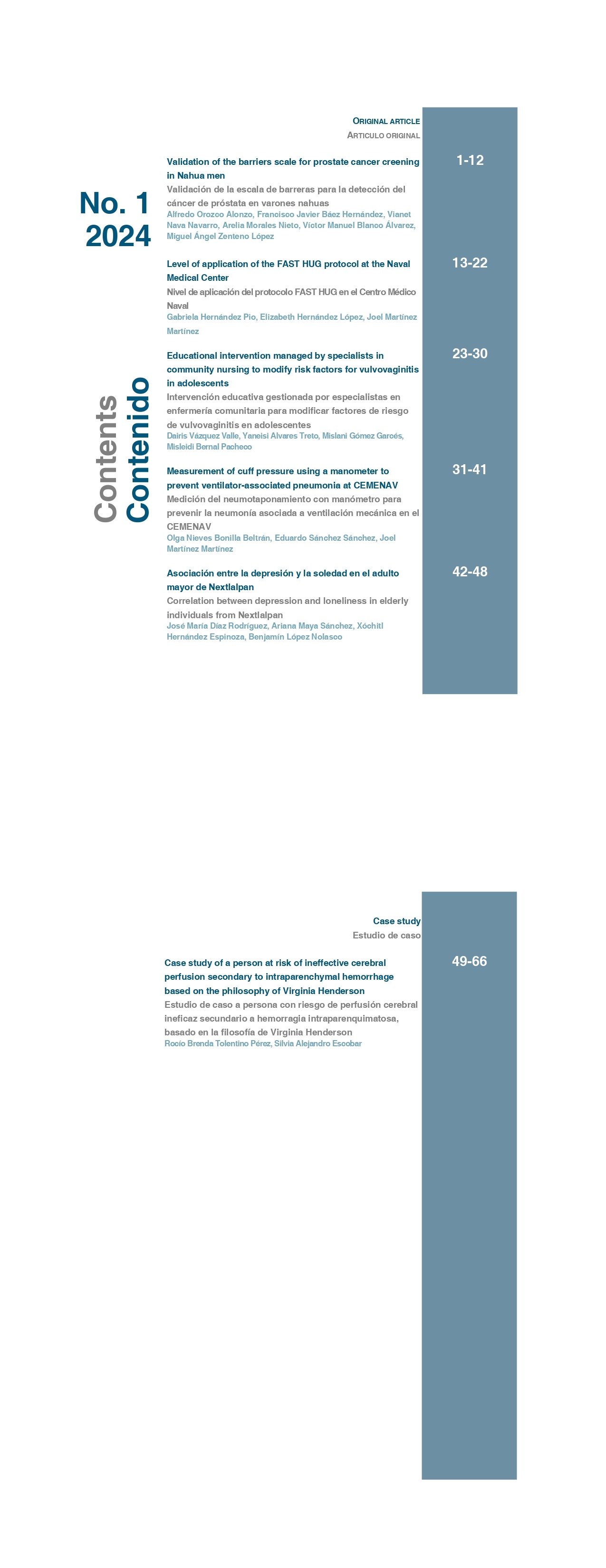Educational intervention managed by specialists in community nursing to modify risk factors for vulvovaginitis in adolescents
DOI:
https://doi.org/10.51422/ren.v23i1.381Keywords:
Vulvovaginitis, Adolescent medicine, Specialist nurses, Risk factor´sAbstract
Introduction: In medical practice, vaginal infections represent a frequent health problem in our environment.
Objective: To assess the effectiveness of an educational intervention managed by community nurse specialists to modify risk factors for vulvovaginitis in adolescents.
Methods: A quasi-experimental study was carried out with 48 adolescents from clinic 15 of the Mataguá polyclinic in Cuba. The variables age, overcrowding, study in boarding schools, level of knowledge of the adolescents before and after the intervention, and way of genital hygiene were analyzed. The results were organized in tables and graphs after processing.
Results: The predominant age range was 12 to 14 years; most adolescents lived in overcrowded conditions and attended boarding schools. A high number reported not having received prior information on the subject. Before the intervention, most of the adolescent girls slept in company, did not wash their genitals properly, and did not know how often they should do it. After applying the educational intervention, the level of knowledge on these aspects increased.
Conclusions: The educational intervention was satisfactory since it achieved significant differences in the level of knowledge before and after the intervention. It is recommended that it be extended to the rest of the study universe and that the procedures carried out in this research be applied to other adolescents whose knowledge needs could be similar.
Downloads
References
- Ortiz-Movilla R, Acevedo-Martín B. Vulvovaginitis infantil. Rev Pediatr Aten Primaria [internet]. 2011 [citado 19 abril 2022]; 13(52): 601-9. Disponible en: https://cutt.ly/teFAO3Kh
- Andres-Domingo P. Alteraciones vulvovaginales (bartolinitis, leucorreas, traumatismos, vaginosis e infecciones de transmisión sexual). Adolescere [internet]. 2019 [citado 19 abril 2022]; 7(1): 26-38. Disponible en: https://cutt.ly/WeFAAm4F
- Ecuador E. Montenegro-Moran EE, De la Torre-Chávez J, Hernández-Velásquez K, Saltos-Calvache M. Prevalencia de infecciones vaginales en adolescentes. Pol. Con [Internet]. 2017 [citado 19 abril 2022]; 2(7): 807-20. Disponible en: https://cutt.ly/ueFASxan
- Sánchez-Gaitán E. Manejo de vulvovaginitis en la atención primaria. Revista Médica Sinergia [internet]. 2018 [citado 19 abril 2022]; 3(8): 13-20. Disponible en: https://cutt.ly/leFADbAE
- Zapata-Martínez JF, Pérez-Muñoz A, Tirado-Otálvaro AF, González JD, Velásquez-Vergara SM. Factores de riesgo asociados a infecciones vaginales y lesiones escamosas intraepiteliales en estudiantes universitarias de Medellín - Colombia. Enferm. glob. [Internet]. 2018 [citado 19 abril 2022]; 17(50): 86-106. Disponible en: https://doi.org/10.6018/eglobal.17.2.275881
- Cabezas Tunja KJ, Zambrano Macías C. Factores de riesgo asociados a la vulvovaginitis en mujeres de edad reproductiva. Pentaciencias [Internet]. 2023 [citado 13 agosto 2024]; 5(3): 167-82. Disponible en: https://doi.org/10.59169/pentaciencias.v5i3.531
- Núñez J, Romano A, Medina M, Cardozo RA. Cambios sugestivos de infección por virus de papiloma humano en estudiantes de una Universidad Pública. Actual Med [internet]. 2021 [citado 13 agosto 2024]; 106(812): 30-7. DOI: http://dx.doi.org/10.15568/am.2021.812.or04
- Guashco BH, Jiménez AL. Conocimiento sobre el virus del papiloma humano en estudiantes mujeres de la Carrera de Enfermería. QhaliKay [Internet]. 2023; 7(1): 26-33. Disponible en: https://cutt.ly/JeFAGNOQ
- Romero FP, Ramírez VE, Muñoz OM, Muñoz MP, González LC, Orellana CC, et al. Lesiones anogenitales por Virus Papiloma Humano. Estudio de prevalencia en niños, niñas y adolescentes no vacunados. Andes pediatr. [Internet]. 2023 [citado 13 ago 2024]; 94(1): 29-36. Disponible en: http://dx.doi.org/10.32641/andespediatr.v94i1.3534
- Sánchez-Malo MJ, Hidalgo-Sanz J, Hernández-Tejedor C, García-Ventura M, Ferrer-Lozano M, Labarta-Aizpún JI, De Arriba-Muñoz A. Déficit de hormona de crecimiento: influencia de la pubertad en la respuesta al tratamiento. Anales de Pediatría [internet]. 2021 [citado 19 abr 2022]; 96(3): 221-29. DOI: https://doi.org/10.1016/j.anpedi.2021.04.003
- Duran-Cañarte AL, Nicole-Yuleidy AQ, Menéndez-González MG. Infecciones Vaginales y Factores de Riesgo en Mujeres en Edad Reproductiva: ¿Cuánto Afecta? Dominio de las Ciencias [internet]. 2022 [citado 19 abr 2022]; 8(2): 289-309. DOI: https://cutt.ly/feFAJcJJ
- López-Villacís NK, Aveiga-Flores ME, Castro-Acosta N del C. Conocimiento sobre salud sexual y reproductiva en adolescentes. DC [Internet]. 2020 [citado 14 ago 2024]; 6(4): 35-49. Disponible en: https://cutt.ly/peFALyVe
- López OMÁ, Castellanos CE, Salazar MJ, et al. Nivel de conocimiento sobre salud sexual y reproductiva en adolescentes de 12 a 18 años de la comunidad Plan de Allende. Rev Mex Med Forense [internet]. 2023 [citado 13 ago 2024]; 8(1): 55-74. Disponible en: https://cutt.ly/oeFAZyxq
Published
How to Cite
Issue
Section
License
Copyright (c) 2024 Revista de Enfermería Neurológica

This work is licensed under a Creative Commons Attribution-NonCommercial 4.0 International License.






